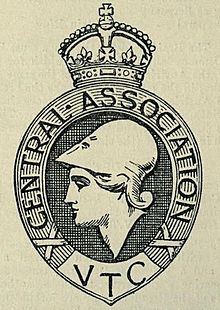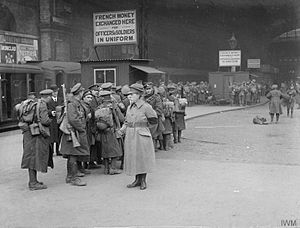Volunteer Training Corps facts for kids
Quick facts for kids Volunteer Training Corps |
|
|---|---|

Proficiency Badge of the Volunteer Training Corps, showing the war goddess Bellona
|
|
| Active | September 1914 – December 1918 |
| Country | United Kingdom |
| Role | Defence from invasion |
| Disbanded | January 1920 |
| Commanders | |
| Notable commanders |
Prince Arthur, Duke of Connaught |
The Volunteer Training Corps (VTC) was a group of volunteers in the United Kingdom during World War I. They helped defend the country at home. This was a time when many men were away fighting in the war. The VTC was made up of men who were too old for regular military service. It also included those who had important jobs or family duties. These duties made it hard for them to join the main army.
Contents
Why the VTC Was Formed
When World War I started in August 1914, many people in Britain wanted to help. They wanted to serve their country, even if they couldn't join the regular army. At this time, Britain relied on volunteers for its soldiers. Many people believed that professional soldiers should fight wars. They thought that local groups should handle home defense. So, many local defense groups started up on their own.
Famous writers like Arthur Conan Doyle and H. G. Wells wrote about how important it was for civilians to help defend the country. At first, the War Office (the government department in charge of the army) was worried. They thought these volunteer groups might stop people from joining the regular army. So, they tried to ban the movement.
However, people kept organizing themselves. A government official named Harold Tennant realized they couldn't stop the volunteers. So, in September 1914, the War Office allowed the Central Committee of the London Volunteer Defence Force to continue. This group became the Central Association of Volunteer Training Corps (VTC). It set up rules for all the different volunteer groups across the country. Lord Desborough became its president.
At first, the VTC was not fully recognized by the government. Its members couldn't hold military ranks. They could only wear a special armband, not a full uniform. Also, they didn't get any money from the government.
Many former soldiers from the National Reserve joined the VTC. This helped the VTC gain respect. Many different types of groups joined, like the United Arts Rifles (which included a famous poet), a unit of deaf people who used sign language, and even a "Ju Jitsu VTC." By June 1915, about 2,000 different VTC groups had formed. They had about 590,000 volunteers!
These groups had to raise their own money to buy weapons. They charged membership fees to do this. The government was worried that the VTC would buy up all the available rifles. So, they made rules that volunteers had to get permission before buying rifles. If groups couldn't afford real weapons, they used dummy rifles, air guns, or borrowed weapons.
What the VTC Did
The VTC became very useful. Its members helped guard important places like naval bases, munition factories (where weapons were made), and railway lines. They also dug trenches around London to help defend the city. Volunteers even helped farmers bring in the harvest.
In October 1915, there was an attempt to make the VTC more official. A bill was introduced in the House of Lords to bring back an old law from 1863. This would have given the VTC more legal standing. General Sir Horace Smith-Dorrien supported this idea. He said the VTC was giving "most valuable aid." However, the bill failed. This meant VTC members still didn't have full legal protection while doing their duties. There was even a worry that if a VTC member shot an escaping prisoner of war, they could be charged with murder.
Official Recognition and Growth

In April 1916, the government found that the old Volunteer Act of 1863 was still valid. They used this law to make the VTC official. VTC Battalions legally became "Volunteer Regiments" of a new "Volunteer Force." Finally, they were allowed to wear khaki uniforms, and the government started providing them with equipment.
In July 1918, the VTC Battalions became part of the regular army's "County Infantry Regiment system." They were called "Volunteer" battalions of their local regiments. When conscription (forced military service) started in 1916, special courts could order men to join the VTC. At first, men could leave after 14 days. So, a new law, the Volunteer Act 1916, was passed. This law made VTC members stay until the end of the war. By February 1918, there were 285,000 Volunteers. About 101,000 of them had been ordered to join by the courts.
Equipment, Training, and Role
In 1917, the VTC started getting P.14 Enfield Rifles and Hotchkiss Mk I machine guns. They trained in military drills and how to use rifles, if they had them. If Germany had invaded, VTC groups were ready to defend important communication lines and major towns. For example, 42 VTC battalions were assigned to defend London.
Volunteers did many other jobs too. They guarded important places, handled ammunition, dug defense lines, helped with farming, fought fires, and transported wounded soldiers. Some units in Worcestershire even helped operate anti-aircraft guns around Birmingham. In 1918, when there was a big shortage of soldiers because of a German attack, about 7,000 Volunteers spent three months defending the coast in East Anglia.
Sometimes, the public made fun of the VTC. People joked that the "GR" on their armbands stood for "George's Wrecks," "Grandpa's Regiment," or "Government Rejects."
The Easter Rising in Dublin
The only time VTC members fought in actual combat was during the Easter Rising in Dublin. This happened on Easter Monday, April 24, 1916. About 120 members of the 1st (Dublin) Battalion of the VTC were returning from a training exercise. They heard about the uprising and decided to march to Beggars Bush Barracks. They had rifles but no ammunition or bayonets.
Irish Volunteers fired at them from a railway bridge. Some VTC members got into the barracks through the front gate. Others went to the back and climbed over a wall. About 40 men at the back of the group were caught in the gunfire from nearby houses. Four of them were killed, including Francis Browning, a well-known cricket player. The VTC men then helped the small group of regular soldiers defend the barracks for eight days. In total, five VTC members were killed and seven were wounded in this event.
Disbandment
The Volunteer Training Corps stopped its activities in December 1918. It was officially disbanded in January 1920. Only the Volunteer Motor Corps remained until April 1921, in case of civil unrest.
See also


